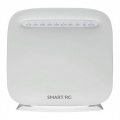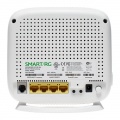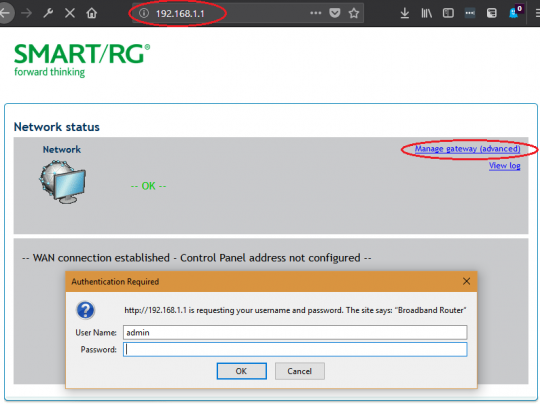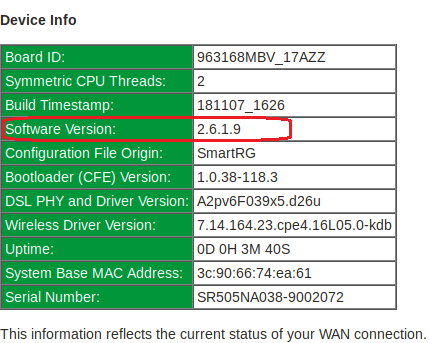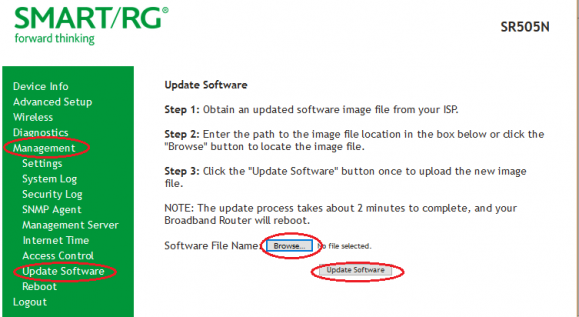Difference between revisions of "SmartRG SR505N Configuration"
| Line 176: | Line 176: | ||
<!--Click on the "Security" subtab , store the NCF DSL password for the wi-fi password.--> | <!--Click on the "Security" subtab , store the NCF DSL password for the wi-fi password.--> | ||
== | ==Configure ADSL Interface== | ||
#Click on "Advanced Setup" | #Click on "Advanced Setup" | ||
Revision as of 11:51, 23 August 2018
Sold from Sep 2014 to Aug 2018
Preparation
Updated: 2018-08-20 Recommended Firmware Version: 2.5.0.14
Before you start configuring the SmartRG SR505n, there are 4 things to check:
- Firmware Check: Check if you're using older firmware and upgrade to the recommended firmware version. If you're unable to access the internet to request newer firmware, note that the screenshots shown and steps outlined may not align with what you see. Contact the support@ncf.ca for assistance if you run into problems.
- Factory Settings and Standard Configuration: These instructions assume you're configuring SmartRG SR505n modem out of the box or after a factory reset. If the modem is not new, it is recommended to reset the modem to the factory defaults by holding down the reset button with a paper clip for ~10 seconds.
- Also, these settings are our recommendations for most NCF members. To learn more about making custom changes to your particular modem, consult the manual.
- Modem Installation - Configure over Ethernet: Consult the SmartRG SR505N modem instruction sheet (page 1) on how to set up the modem and connect to it over ethernet. We do not recommend configuring your modem over a WiFi connection.
- Configurations Methods: The 2 main ways of configuring the SmartRG SR505n modem:
- Using a custom configuration File: Request a custom configuration file for your NCF DSL from support@ncf.ca.
- Manually following configuration steps
- Configuration Options:
- Routed Operation with WiFi - Standard configuration for most members with SmartRG SR505n serving as both modem and WiFi router.
- Routed Operation with separate WiFi Router - Recommended configuration for members with their own WiFi router. The modem will make the PPPoE authentication and both devices will negotiate DHCP.
- Bridged Operation with separate WiFi Router - (Advanced) for members with their own routers and are knowledgeable about managing it themselves. The router with handle both authentication and DHCP.
Configure for Routed Operation with WiFi
The SmartRG SR505n modem router supports both ADSL mode and VDSL mode. Provided it is configured correctly, it can be switched between ADSL and VDSL plans without the owner having to buy a new modem or even reconfigure your existing one.
- Note: Fees for changing plans may still apply. Consult: DSL Rates
Checklist
| Configuration Steps | Key Parameters | Check | |
|---|---|---|---|
| 1. | WAN Cleanup | Remove ppp0.1 from WAN Service Table | ☐ |
| 2. | Enable ADSL interface | ATM: vpi:0 vci:35
Configure for both FAST and INTERLEAVED DSL latency |
☐ |
| 3. | Enable VDSL interface | PTM:
Configure for both FAST and INTERLEAVED DSL latency |
☐ |
| 4. | Configure ADSL Interface | PPPoE
PPPoE username: your NCF account ID (format: xx000@ncf.ca) PPPoE password: your DSL password
|
☐ |
| 5. | Configure VDSL Interface | PPPoE
PPPoE username: your NCF account ID (format: xx000@ncf.ca) PPPoE password: your DSL password
|
☐ |
| 6. | UPnP | Disable uPnP | ☐ |
| 7. | WiFi | Set WiFI SSID
Security:
|
☐ |
| 8. | Secure Modem | Change modem Admin password
Disable Support role |
☐ |
| 9. | Remote Access | ACS | ☐ |
| 10. | Configure System Log | Enable System Log | ☐ |
| 11. | Internet Time | Add time.nrc.ca to Internet Time servers | ☐ |
| 12. | Backup Settings | Backup Running Settings | ☐ |
Getting Started
1. Enter http://192.168.1.1 info the address bar at in your web browser. Click on Manage Gateway (advanced) and login with username: admin and password: admin (if your modem has been properly reset. If not try your NCF DSL password).
WAN Cleanup
2. Click on the Advanced Setup menu, then on the WAN Service sub-menu. Select the Remove option on the ppp0.1 interface listed on WAN Service Setup table and click Remove at the bottom of the page.
Enable ADSL interface
3. Under the Advanced Setup menu, click on the Layer2 Interface and then ATM Interface. Click Add and proceed
4. On the ATM PVC Configuration page, select the following:
- VPI:0 and VPI:35
- DSL Latency: Select both
- Path0(fast)
- Path1(interleaved)
- Apply/Save
5. Confirm you have configure the ADSL (ATM) interface correctly with the image below:
Enable VDSL Interface
4. On the 'PPP Username and Password' page, fill the username and password details in the field highlighted in red. Be sure to scroll to the bottom of this page checking that "Enable Firewall" and "Enable NAT" are all checked. Click "Next". PPPOE set up File:Smartrg 505n vdsl NAT SIP 005.png
Configure ADSL Interface
Click on "Next"
Click on "Next" Configuring ADSL2+ 10/11
Click on "Apply/Save". PPoE config save
Turn Off UPnP
- Click on Advanced Setup on the left. Below it other options appear.
- Select UPnP
- Uncheck the box
- Save the changes with Apply/Save
Configure ADSL Interface
- Click on "Advanced Setup"
- Click on "Layer2 Interface"
- Click on "ATM Interface"
- Click on "Add"
- Ensure that VPI is 0 and that VCI is 35.
- Ensure that Fast and Interleaved are selected under DSL Latency.
- For everything else, use the defaults.
- Scroll to the bottom of the page, and click "Apply/Save".
- Click "Advanced Setup"
- Click "WAN Service"
- Click "Add"
- From the drop-down box, select "atm0/(4_0_35)"
- Click "Next"
- Ensure "PPPoE" is the active choice.
- Ensure "Service description" is as shown.
- Click "Next".
Ensure "Enable Firewall", "Enable NAT" and "Enable SIP" are checked. Scroll to the bottom of the page and click "Next". Configuring ADSL2+ 8/11
Click on "Next" twice
Click on "Apply/Save" Configuring ADSL2+ 11/11
You are done adding the ADSL settings. Now, skip ahead to Wireless Configuration.
Wireless Configuration
Continuing now to set the Wireless configuration
- Ensure Enable Wireless is checked
- The SSID is set to NCF plus a random number (NCF uses the last 4 digits of the serial number), such as NCF_1234. It is recommended you not use your first or last name, or street address as this information is broadcast and other people in your area will be able to associate the signal with which home it is coming from.
- Click on Apply/Save at the bottom.
- Click on Security on the left.
- Set the Network Authentication to WPA2-PSK
- Set the WPA/WAPI Ecryption to AES
- Uncheck Use base MAC address as WPA/WAPI passphrase
- Set the WPA/WAPI passphrase to be your DSL-Password
- Click Apply/save.
Password protect the Admin Role
- Click on Management on the left. Below it other options appear.
- Select Access Control
- Select Passwords
- Enter admin for the User Name
- Enter admin for the Old Password
- For the New Password use your DSL-Password or another strong password.
- Enter it once and again below to confirm
- Save the changes with Apply/Save
Click on "Device Info". A pop-up log-in screen appears, and asks for sign-in. Use the User-ID admin and the DSL-Password just set. Return to the same configure page you were just at.
Configure as Bridge
Do this only if you prefer to use your own external router rather than the one built into your SmartRG unit.
- Connect power and turn on the modem with the button on the back.
- Connect an Ethernet LAN cable to one of the yellow rear ports
- In the browser's address bar, enter the IP address for the modem interface page: 192.168.1.1
- If the modem is fresh from the factory, use the default user name and password to gain access
- user: admin
- password: admin
If the modem was previously configured for someone, the password would be the previous user's DSL password. If it is unknown then do a reset to factory default, using a paper-clip in the reset hole on the back. Hold for 6 to 9 seconds to reset. The user name and password will now be as above.
- Click on Advanced Setup and WAN Service and click on Add
- The defaults are fine; click on Next.
- Click on Bridging and ensure the 802.1P and 802.1Q are set to 0 and 35, then click on Next.
- Click on Apply/Save
- Done!
See screenshots below:
Configuring for Bridge Mode 1/5 Configuring for Bridge Mode 2/5 Configuring for Bridge Mode 3/5 Configuring for Bridge Mode 4/5 Configuring for Bridge Mode 5/5
Firmware
We recommend that you only do firmware update over an ethernet connection and NOT via wifi. Also DO NOT power off the modem in the middle of a firmware update
The current firmware available to the NCF Office is 2.5.0.14. You can verify your firmware by checking the software version on the Device Info page.
To request a copy of this firmware email [support@ncf.ca]. To install this new firmware onto your modem perform the following steps:
- Download the firmware file and save it to a location on your computer that you can find easily.
- Open a web browser and go to the address http://192.168.1.1
- Select Manage Gateway (Advanced) and log in (by default the username is admin and password is your dsl password as shown in Getting Started above)
- Click on Management → Update Software
- Click on Choose File
- Upload the firmware file that you downloaded in step 1.
- Click Update Software
Note: the modem will reboot once the new firmware has been uploaded. This process may take up to 15 minutes to resync (DSL light returns to solid green) and reconnect (the internet light starts blinking again).
See Also
- Modem Configuration - for a complete list of instructions for all NCF modems
- About SmartRG modem lights
- SmartRG SR505N modem manual
- NCF SmartRG SR505N modem instruction sheet
- SmartRG SR505N Changing WiFi Channels
- Dynamic DNS
- Port forwarding with the SmartRG SR505N

